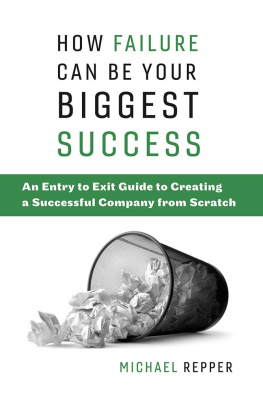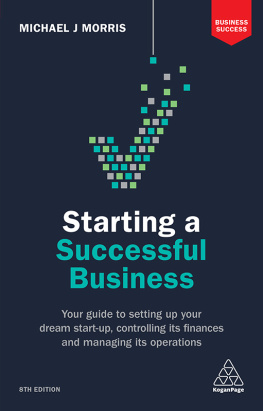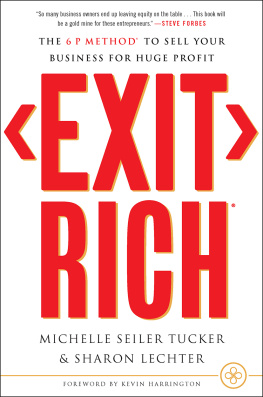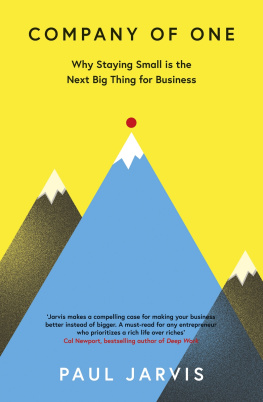Copyright 2018 by Michael Repper
All rights reserved. This book or any portion thereof may not be reproduced or used in any manner whatsoever without the express written permission of the publisher except for the use of brief quotations in a book review.
Print ISBN: 978-1-54393-228-7
eBook ISBN: 978-1-54393-229-4
Prologue
T he history of business is long. From the start of the first public company on the New York Stock Exchange in 1792 until now, the way in which companies do business has been well documented. Substantial works have been written about the strategies of successful businesses and the growth of a corporation; this book is not one of them. My goal for this book is to explain to the reader the potential failures involved in starting a business by using my own experience, not just from the standpoint of the financial and operational view, but taking an overall approach from business concept to the eventual sale of my company for a 5-time EBIT return.
Throughout this text I will discuss my approach and the thoughts I had before, during, and after I started my company, including how my business almost went bankrupt, and how I eventually turned it around to prepare it for sale. I will discuss my mistakes in selecting partners because I was too scared to do it myself, and my errors in agreeing to contracts that limited my ability to control the company I built, and finally, how I was able to take back control, establish growth, remove one of my partners, and then structure the sale of the company to eventually allow myself the financial freedom that I set out to achieve by starting the company in the first place.
As a reader of this book. I hope that you will learn how an idea can become a company, how a company can become a burden if not structured correctly, and how a vision for a company can be a horrible thing if you dont have the skills to implement it properly or the personnel with the same passion for success as yourself. Using my personal experiences building a company, I will detail what decisions are necessary to be successful and how to financially structure your company not only to make money but to reduce risk and eliminate the unpredictability of sales cycles. I will share with you how to evaluate sales functions, secure capital, build an operations process, establish your accounting processes, utilize the power of marketing to build your companys presence, and ultimately avoid the pitfalls I made during my companys life cycle. To do this I will walk you through all the mistakes I made while building my company, detailing my biggest concerns and many sleepless nights worried about making payroll, paying interest on credit lines, and stressing over the families of the employees that left jobs to follow me in making my dream of starting a company a reality. I will be straight with you as to what mistakes really cost me money and what I did to overcome them. I am not interested in savvy business language and detailed financials. While they will be integral in helping you successfully run your business and we will discuss them as areas of opportunity, I want to give it to you straight. Businesses dont run on numbers, they run on people. They run on everyday decisions. Financials and analysis are the results of your decisions, not the path to evaluating the future. I want to take you through the pitfalls of the daily items you will deal with as a business owner, which, if not handled correctly, will cause you significant loss, loss you cant afford when youre starting a business from scratch and you have everything on the line.
Chapter
My Company Story
and Why It Matters to You
T he company I started was an Energy Efficiency Company, primarily a lighting company that focused solely on light-emitting diode (LED) technology. I started a company in an industry that was in the beginning of its life cycle, on a growth trajectory, operating much like the Wild West, with each company having its own product, its own design, its own label and marketing, and none being more established than the other. See, lighting had been an established business, since Edison first created the carbon filament light bulb in 1879; however, LED technology changed the entire market. It was a game changer. As we know, a light bulb was designed for one purpose creating light in a dark spot. It had been that way for over 200 years. Sure, there were different technologies like fluorescent or incandescent, and there are different shapes and colors of light bulbs. But a light bulb was largely inconsequential to a client, whose primary interest in purchasing a light bulb essentially came down to whether or not it would turn on. Sales staff typically sold lighting on the basis of cost and brand name, and manufacturers sold through distributors where the distributor routinely took orders for lights that failed during that specific period. They sold that client other electrical items and the light bulb was a byproduct of already having an established relationship with the client.
With the advent of LED lighting, the light bulb became more than a container for light. It became a financial tool. It was no longer a low-cost option, but now was a capital investment that required companies to get an acceptable return. The same sales staff that used to just take orders now was tasked with determining the feature benefit (which we will talk more about in the marketing section later in the book) of the product and how to take something that used to cost $1.50 and sell it for $50 a unit. Large companies couldnt respond. They had infrastructure in place to take orders. They had staff that knew a light turned on but not how to sell the economics of the business.
This change was my business opportunity. I was a CPA, and I understood that this technology was a game changer, making lighting more of a strategic decision for companies and no longer a byproduct order placed with a distributor. It was a product that used to have a 30% margin on a $1.50-unit price that now could generate 50% on a $55 a unit price. However, you couldnt sell it the same way, and you had to maximize the economic value and pain points of the buyer. You have to get a client to invest in these light bulbs.
That was the advantage I felt I had. I was skilled in financial analysis, and I know how to achieve a return, so I studied like crazy on lighting and designed ways to position the product differently. I focused on the savings of the product and the increase in cash flow a company could see from reduced utility costs. I looked at the increased profits a company could see with this investment versus the previous value of the light bulb, which was just the fact that the light turned on. I researched all the differences in lighting quality and color, anything I could drive as an advantage to making the change. I came up with new financing programs that I designed to reduce the upfront cost of investing in lighting upgrades. My business focused on taking something that was old and making it new. Thats one of the ways in which business owners like yourselves will look to start your companies. There are products and industries that are used every day that can be improved upon, whether that be in product development, customer service, or sales processes. Mine was a business process, so keep in mind you dont have to have the invention that changes the world to start a large, successful company. You just have to have a vision of what the company can be and how to get there.
Like Amazon, who focused on offering books a different way, my concept was simple. LED lighting was expensive, and because it was expensive it required a different decision to be made by different people in the company, ones with more authority to commit. Because of that difference, I looked at ways to work around that constraint. We would install light-emitting diode (LED) lighting into entire buildings without an upfront payment. Instead we would calculate what they would save from the lighting and then charge them a portion of that savings for a period of time, which would allow them to pay it as an operating expense versus capitalizing it (which is frowned on when buying a degrading product such as lighting).











